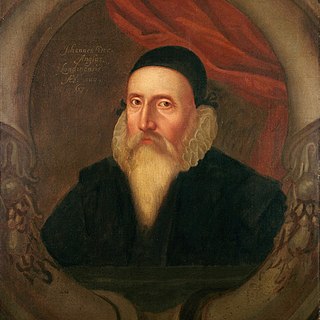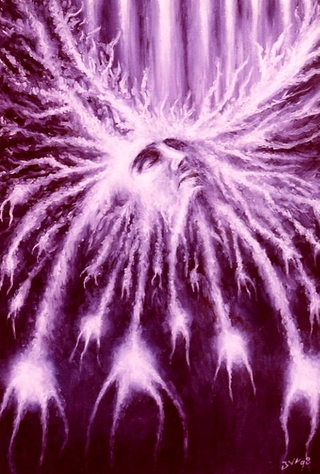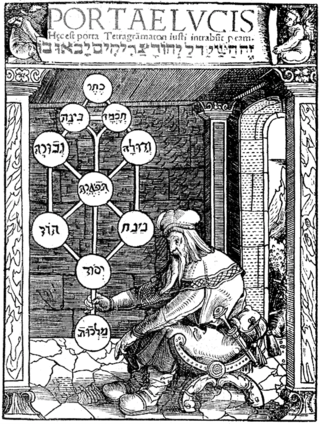A magical organization or magical order is an organization or secret society created for the practice of initiation into ceremonial or other forms of occult magic or to further the knowledge of magic among its members. Magical organizations can include Hermetic orders, esoteric societies, arcane colleges, and other groups which may use different terminology and similar though diverse practices.
Theurgy, also known as divine magic, is one of two major branches of the magical arts, the other being practical magic or thaumaturgy. Theurgy describes the ritual practices associated with the invocation or evocation of the presence of one or more deities, especially with the goal of achieving henosis and perfecting oneself.

Hermeticism or Hermetism is a philosophical and religious system based on the purported teachings of Hermes Trismegistus. These teachings are contained in the various writings attributed to Hermes, which were produced over a period spanning many centuries and may be very different in content and scope.

Ceremonial magic encompasses a wide variety of rituals of magic. The works included are characterized by ceremony and numerous requisite accessories to aid the practitioner. It can be seen as an extension of ritual magic, and in most cases synonymous with it. Popularized by the Hermetic Order of the Golden Dawn, it draws on such schools of philosophical and occult thought as Hermetic Qabalah, Enochian magic, Thelema, and the magic of various grimoires. Ceremonial magic is part of Hermeticism and Western esotericism.

Enochian magic is a system of Renaissance magic developed by John Dee and Edward Kelley and adopted by more modern practitioners. The origins of this esoteric tradition are rooted in documented collaborations between Dee and Kelley, encompassing the revelation of the Enochian language and script, which Dee wrote were delivered to them directly by various angels during their mystical interactions. Central to the practice is the invocation and command of various spiritual beings.

Astral projection is a term used in esotericism to describe an intentional out-of-body experience (OBE) that assumes the existence of a subtle body, known as the astral body or body of light, through which consciousness can function separately from the physical body and travel throughout the astral plane.

A subtle body is a "quasi material" aspect of the human body, being neither solely physical nor solely spiritual, according to various esoteric, occult, and mystical teachings. This contrasts with the mind–body dualism that has dominated Western thought. The subtle body is important in the Taoism of China and Dharmic religions such as Hinduism, Buddhism, and Jainism, mainly in the branches which focus on tantra and yoga, where it is known as the Sūkṣma-śarīra. However, while mostly associated with Asian cultures, non-dualistic approaches to the mind and body are found in many parts of the world.
The following outline is provided as an overview of and topical guide to spirituality:

The astral body is a subtle body posited by many philosophers, intermediate between the intelligent soul and the mental body, composed of a subtle material. In many recensions the concept ultimately derives from the philosophy of Plato though the same or similar ideas have existed all over the world well before Plato's time: it is related to an astral plane, which consists of the planetary heavens of astrology. The term was adopted by nineteenth-century Theosophists and neo-Rosicrucians.

Western esotericism, also known as esotericism, esoterism, and sometimes the Western mystery tradition, is a term scholars use to classify a wide range of loosely related ideas and movements that developed within Western society. These ideas and currents are united since they are largely distinct both from orthodox Judeo-Christian religion and Age of Enlightenment rationalism. It has influenced various forms of Western philosophy, mysticism, religion, pseudoscience, art, literature, and music.

The astral plane, also called the astral realm or the astral world, is a plane of existence postulated by classical, medieval, oriental, and esoteric philosophies and mystery religions. It is the world of the celestial spheres, crossed by the soul in its astral body on the way to being born and after death, and is generally believed to be populated by angels, spirits or other immaterial beings. In the late 19th and early 20th century the term was popularised by Theosophy and neo-Rosicrucianism.
In esoteric cosmology, a plane is conceived as a subtle state, level, or region of reality, each plane corresponding to some type, kind, or category of being.
Within Thelema, the Great Work is the spiritual endeavor aimed at realizing one's True Will and achieving a profound mystical union with the All. This path, crafted by Aleister Crowley, draws inspiration from Hermetic alchemy and the Hermetic Qabalah. The cornerstone of Thelema is the Book of the Law, received by Crowley in 1904 through a communication with the entity Aiwass. This text became the central scripture, heralding a new Aeon for humanity and outlining the principles of Thelema.

The Alpha et Omega was an occult order, initially named the Hermetic Order of the Golden Dawn, co-founded in London, England by Samuel Liddell MacGregor Mathers in 1888. The Alpha et Omega was one of four daughter organisations into which the Hermetic Order of the Golden Dawn fragmented, the others being the Stella Matutina; the Isis-Urania Temple led by A. E. Waite and others; and Aleister Crowley's A∴A∴. Following a rebellion of adepts in London and an ensuing public scandal which brought the name of the Golden Dawn into disrepute, Mathers renamed the branch of the Golden Dawn remaining loyal to his leadership to "Alpha et Omega" sometime between 1903 and 1913. "The title was usually abbreviated as A.O." and according to some sources its full name was "Rosicrucian Order of Alpha et Omega". All of the temples of the order appear to have gone out of existence by the Second World War.

Hermetic Qabalah is a Western esoteric tradition involving mysticism and the occult. It is the underlying philosophy and framework for magical societies such as the Golden Dawn, has inspired esoteric Masonic organizations such as the Societas Rosicruciana in Anglia, is a key element within the Thelemic orders, and is important to mystical-religious societies such as the Builders of the Adytum and the Fellowship of the Rosy Cross.
Neoplatonism was a major influence on Christian theology throughout Late Antiquity and the Middle Ages in the East, and sometimes in the West as well. In the East, major Greek Fathers like Basil, Gregory of Nyssa and Gregory of Nazianzus were influenced by Platonism and Neoplatonism, but also Stoicism often leading towards asceticism and harsh treatment of the body, for example stylite asceticism. In the West, St. Augustine of Hippo was influenced by the early Neoplatonists Plotinus and Porphyry. Later on, in the East, the works of the Christian writer Pseudo-Dionysius the Areopagite, who was influenced by later Neoplatonists such as Proclus and Damascius, became a critical work on which Greek church fathers based their theology, like Maximus believing it was an original work of Dionysius the Areopagite.
Platonism, especially in its Neoplatonist form, underwent a revival in the Renaissance as part of a general revival of interest in classical antiquity. Interest in Platonism was especially strong in Florence under the Medici.
Neoplatonism is a version of Platonic philosophy that emerged in the 3rd century AD against the background of Hellenistic philosophy and religion. The term does not encapsulate a set of ideas as much as a series of thinkers. Among the common ideas it maintains is monism, the doctrine that all of reality can be derived from a single principle, "the One".
Okhêma refers to the "carrier" or "vehicle" of the soul, serving as the intermediary between the body and the soul, in Neoplatonism and the philosophical traditions it influenced.










